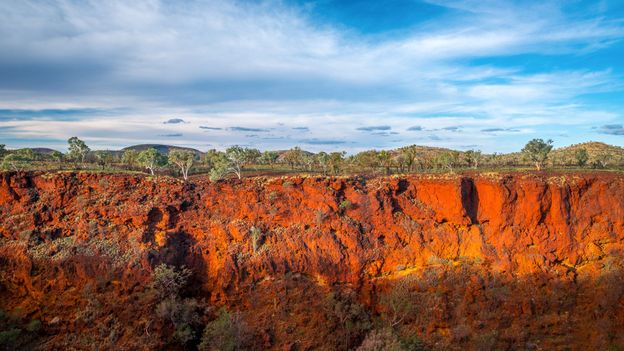What is the Great Artesian Basin?
Before the 1980s, more than 1,000 bores flowed freely into drains, wasting thousands of megalitres a year.(Supplied: DRDMW)
It is one of the largest underground freshwater reservoirs in the world, stretching south from Cape York in Queensland to Dubbo in New South Wales, west to Coober Pedy in South Australia and into the Northern Territory.
It's estimated there are about 65 million gigalitres of underground water in the basin — enough to fill Sydney Harbour 130,000 times.
Water emerges from the basin from cracks in the rocks and aquifers, which flow into springs, creeks and rivers.
It lies under more than 1.7 million square kilometres of inland Australia, with about 70 per cent beneath Queensland.
For more than 60,000 years, Aboriginal and Torres Strait Islander people have relied on basin water to live in dry inland areas, and its springs and rivers hold important cultural significance to First Nations people.
The first bores built were in Bourke in 1878, Barcaldine in 1886 and Cunnamulla in 1887.(Supplied: State Library of Qld)
In 1878, European settlers built a shallow bore near Bourke, which produced flowing water and heralded a new era of water supply.
By 1899, it's believed more than 500 bores had been sunk, and by 1960 there were more than 3,000 free-flowing bores across Queensland alone.
Now, it's one of the most significant artesian basins in the world, generating economic benefits of around $13 billion each year and supplying water to 120 towns.
The basin supplies water to 180,000 people and 7,600 businesses across Australia.(Supplied: DCCEEW)
But with so many bores, pressure and volume in the Great Artesian Basin dropped and so began the project to cap and pipe all the free-flowing bores across the basin.
There are a number of restrictions that come with drilling bores in order to protect the basin and to ensure the water is viable for human consumption.
It's a project that is still ongoing, but it started with one western Queensland grazier.
Making the most of the basin
In 1988, John Seccombe's Muttaburra property Kenya was in drought and the grazier was having issues accessing water.
He had a number of shallow bores but knew there was a better way to ensure permanent access to water across his property; after some experimentation he put in a new artesian bore.
John Seccombe revolutionised the way graziers access water from artesian bores.(Supplied: John Seccombe)
"Ninety-five per cent of water that came out of a free-flowing bore was totally wasted and that led to a loss of pressure in the basin," Mr Seccombe said.
"I couldn't understand why you couldn't utilise the pressure in the basin to pipe water around the property."
And that's what he did, laying pipes across his property and sending the water to parts of the land he'd never been able to before.
Mr Seccombe was the first to do this.
Word spread about this method — he said the Queensland government was initially dubious — but by 1993 it was convinced and asked him to run pilot programs helping other graziers cap and pipe their bores.
By 1996 Mr Seccombe helped design a national program that brought the four relevant states and territories together.
Thousands of kilometres of piping was installed to move water around Kenya Station.(Supplied: John Seccombe)
Mr Seccombe chaired both the federal and Queensland bodies until he retired in 2003.
The Queensland scheme is the Great Artesian Basin Rehabilitation Program, which receives joint funding in order to continue
capping and piping bores across the basin.
The state government says it saves 226,000 megalitres of water every year, equivalent to 90,000 Olympic pools' worth of water.
The joint funding for this program is set to expire in June, but Hamish Butler, executive director south region at the Department of Regional Development, Manufacturing and Water, says he is confident it will be continued.
"The works have helped stabilise groundwater pressures, which has benefited landholders, town water supplies and industries," Mr Butler said.
Despite the uncertainty of continued funding, there are hundreds of bores to be rehabilitated.
"That's going to save another 76,000 megalitres of water annually," Mr Butler said.
Federally, the Great Artesian Basin and Other Regional Aquifers Water Plan requires states to have all stock and domestic bores watertight by September 2, 2032.





